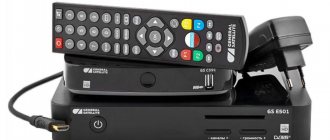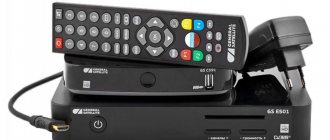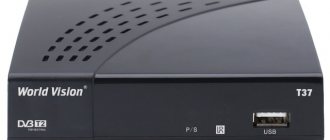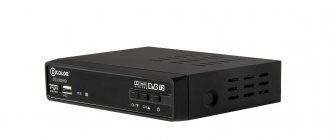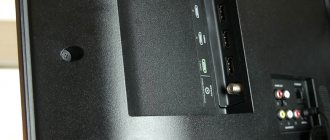Have you installed a satellite dish on your roof or balcony, and now you need a hint as to which satellite receiver is best to buy? No problem. To avoid any unpleasant surprises after your purchase, read on for basic definitions and information about satellite decoders. They are compatible with various formats, signals and encrypted channels offered by paid operators.
When using an access card to watch encrypted channels for satellite television, you need to buy a tuner that will have a special receiving slot for cards.
Do you need a set-top box to watch digital TV, and how does it work?
Recently, according to the adopted law of the Government of the Russian Federation, analogue broadcasting has stopped working. This means that all citizens must switch to digital to watch television. This requires a special device to receive the signal. However, these are not all the functions of the tuner. Let's look at what else you need a digital set-top box for your TV below.
What is a prefix?
A set-top box is a special device for receiving a signal, decoding it and transmitting it to any television, regardless of brand and model. The usual connection of devices is carried out using an HDMI connector. In addition, tuners allow you to connect a hard drive, mouse and keyboard.
Do you need an attachment?
When analog TV was cancelled, many users began to ask whether a set-top box was needed to watch digital television? If you want to watch channels in high quality, you cannot do without this device.
The fact is that an indoor antenna does not provide good reception and transmission of a TV signal. In addition, it only picks up a few channels, usually 2-3. In addition, you have to walk around the entire room.
Only in some places it is possible to catch at least some signal.
There are no such problems with the console. If you use it without a provider, you are guaranteed to receive 20 free channels approved by the President of the Russian Federation. If the connection is made, for example, through MTS or Rostelecom, the package will be expanded. The cost of the service in this case depends on the operator’s conditions.
In addition, the device can be placed anywhere. No need to carry the device around the room. It will provide a high-quality signal, regardless of the installation location. Therefore, to watch high-quality television, you cannot do without a set-top box.
Types of broadcasting
There are three signal transmission options:
- satellite (DVB-S2, DVB-S);
- cable (DVB-C);
- terrestrial (DVB-T2).
A satellite receiver is an integral part of the satellite television “team”. A device connected to the dish picks up the signal and displays it on the screen. Such prefixes are conventionally divided into three groups. The first group is considered the most popular. It is designed for the widest masses of television viewers and is used to watch open channels. The second group includes receivers with a built-in decoder. They work with special access cards. In addition, this includes equipment designed to work with a specific provider. The third group is multimedia terminals that, in addition to broadcasting, perform a huge number of additional functions.
A cable receiver is a device that supports a signal and broadcasts a program package from a regional provider. To become a cable network subscriber, it is important to be within the operator’s coverage area, in addition to the receiver, to have an antenna, converter, power supply and RF cable.
The third version of set-top boxes works with digital broadcasting. Signal reception is carried out by a conventional compact indoor antenna. Such receivers are oriented towards SD and also support HD resolution.
Naturally, satellite broadcasting has the highest quality picture, cable television is in second place, and the most common terrestrial TV closes the top three.
Why do you need a receiver for your TV? | WHO?WHAT?WHERE?
A digital receiver is a modern device for television equipment. We are talking about a special set-top box designed to receive a signal.
In Russian regions, broadcasting of the first set of digital channels has already begun, and in some places the second has been launched. Let's figure out why you need a receiver for your TV.
What is a receiver?
Recently there was a message about the end of the era of analogue broadcasting in Russia, which will come in the coming years. Only digital TV will be broadcast. A receiver is required to receive it. Some devices have it by default, while others do not, so they require an additional set-top box.
The receiver is a compact device that receives a TV signal in DVB T2 format. The device looks like a small box.
The number of channels it receives is still small - no more than 23, of which 3 are radio and 20 are broadcast. There is a possibility that a third multiplex will be launched (although the relevant departments have a negative attitude towards this), which will lead to the appearance of HD channels.
The set-top box is used to decode the signal received by the antenna. The device is connected to it and the TV, then a minimum of settings are made. As a result, we get access to a high-quality image with clear sound without interference and other disadvantages.
This receiver is easy to use, and you don’t have to pay for its use. For high-quality signal reception, an antenna installed in the correct position is sufficient.
Receiver functions
Using the set-top box, a high-quality digital TV signal is received. Manufacturers offer a large number of similar receivers, trying to diversify their functions as much as possible.
Therefore, the receiver can be used for different purposes.
It allows you to temporarily pause the broadcast, start recording a broadcast program, or connect a third-party drive from which video and music will be played.
They can also offer the following:
- subtitles;
- TV guide;
- teletext;
- access to the Internet.
An extensive range allows you to choose a receiver that is ideally suited to the requirements of each user. Products from BBK and Rolsen are more popular than other brands, as these manufacturers offer the most reliable equipment.
Do you need a receiver? You must answer this question yourself. If purchasing a TV with built-in support for this technology is not yet part of your plans, then pay attention to the option described above.
If you decide to purchase, keep in mind several parameters - manufacturer, functionality, number of additional options. You can use the set-top box with any TV, including CRT, although the LCD image will be better.
Installing the console does not require much effort. If you have an antenna, connecting to a receiver will provide access to free high-quality television. There are few channels, but they are all available around the clock.
Criterias of choice
The capabilities of modern AV receivers produced by the largest manufacturers these days are quite difficult to highlight. That is why different models do not have obvious advantages that could be decisive when choosing a particular device. In any receivers, it is better to identify distinctive features that could be based on when choosing the optimal model.
Multichannel audio decoder
When selecting a receiver, you need to pay attention to the support, since the volumetric spatial effect of movie audio will largely depend on this. A good receiver must process all existing audio coding standards, otherwise the operation may not be correct
For example, if the decoder does not have the ability to contact the DTS signal, you simply will not be able to watch movies recorded in this format. This can only be done if you purchase an optional outdoor DTS decoder. That is why, when purchasing an AV receiver for a home theater, you should pay attention to the presence of decoders for standard digital formats.
Interfaces
The HDMI interface is considered universal; today it is a standard and is available on almost all models. The HDMI receiver provides multifunctional, full-fledged connection to the following types of ports:
- Blu-ray player;
- DVD player;
- game console;
- satellite receiver;
- PC or laptop.
This will significantly simplify the connection, as well as further broadcasting of multimedia files from any mobile devices.
Coaxial and optical connectors provide effective switching for a CD player, as well as a computer audio card.
Don’t forget about popular network interfaces, such as Wi-Fi, as well as the Internet and DLNA, which provide maximum freedom in organizing a multi-community.
Useful features
The vast majority of receivers allow you to process the incoming video signal: both analog and digital, including 3D. This option will be useful if you intend to play 3D content from devices connected to the receiver. Don't forget that all existing devices support the HDMI version.
These days, almost any setup offers HDMI 2.0 connectivity with 3D support at 4K resolution, can convert video to digital, and upscale to 4K. This feature is called upscaling, it allows you to watch low-resolution videos on a high-resolution display.
For novice users, an AV receiver model that provides its own sound auto-tuning system using a measuring microphone will certainly be useful.
No less useful when operating the AV receiver will be the presence of a graphical user menu, which is displayed on the display, as well as a learning remote control, which has its own memory for macro commands.
Amplifier
Here the principle of operation is very simple: the greater the power consumption, the more efficient the amplifier will operate. However, do not forget that too high power parameters are just as dangerous as insufficient ones. A suitable value for a room of 20 square meters. m will be considered a receiver of 100 W per channel; for small halls you can limit yourself to compact mini-receivers of low power
The perception of the audio largely depends on the output characteristics of this device; it is important that the power is distributed equally across all channels
TV receiver: what, why and how?
Each of us loves to watch a good film, useful program or the latest news. But not everyone knows what a TV receiver is? What is it for, and how to choose it? Today you will find out all the answers. And, having learned everything you need, you can make your vacation even more comfortable. And maybe even give valuable advice to friends if they are planning to purchase this device.
What is a TV receiver/receiver for digital TV?
This is a device (set-top box) that receives a digital broadcast signal and then converts it to analog. This signal is then output via a Scart or Rca connector, or converted to digital and output via an HDMI connector. This uses technology that compresses video into Mpeg-4 (Mpeg-2) format.
VVK SMP124HDT2
One of the most popular models of TV set-top boxes among our compatriots. Inexpensive, versatile and high quality.
Outputs:
- RCA (tulips);
- USB type 2.0 interface;
- HDMI.
The receiver easily supports the main compression formats (MPEG-1/2/4) and works with the H.264 codec. The device produces a pretty decent picture in Full HD and supports working with external drives (AVI, MKV). The firmware has a built-in TV program and teletext for synergy with terrestrial television.
Owners generally speak positively about the model. It has everything you need to work with most broadcast networks, and some minor flaws and other oddities are more than compensated for by the low price tag. This device can be called a solid average, which will be useful to many who are hungry for digital TV.
Digital terrestrial receiver - what is it and how does it work?
Today in Russia they have abandoned the use of analog television in favor of digital television. Now, to watch TV programs, it is not enough to have a TV and an antenna.
In order for the equipment to work, people must purchase special devices.
Before visiting retail outlets, you should find out what a digital receiver is, how to connect it correctly, how it works, and the rules for choosing a decoder.
Types of broadcasting
Digital television is a new generation format that involves encoding and subsequent transmission of audio and video through special channels. Authorized international organizations have established several digital broadcasting standards, the list of which should be expanded:
- American;
- European;
- Japanese standard.
Digital television is classified according to the type of signal transmission. Terrestrial (terrestrial) involves the use of special repeaters, broadcast receivers, and built-in TV tuners. Cable – provided by provider companies, connecting entire houses and areas to their cable. Satellite, involves the installation of dish antennas that receive signals from low-Earth orbit.
Important! On the territory of the Russian Federation, digital television provider companies use the European broadcast format.
Digital television TV tuners – decoders, receivers, set-top boxes. These devices are designed to receive, decrypt and transmit video and audio signals. Many modern TVs have built-in tuners, the type of which is indicated by manufacturers in the technical documentation.
If the receiver accepts a different format, then to watch digital television you will need to purchase another decoder. External set-top boxes are very popular among Russian citizens. The demand for such devices is due to the fact that not everyone has the opportunity to purchase modern TV or satellite dishes.
They can even be installed on regular TVs by selecting the appropriate modification.
The need for a set-top box
The rapidly growing popularity of dvb t2 tuners is due not only to the abandonment of analogue television, but also to a host of advantages:
- affordable prices, so receivers can be purchased by people of any income level;
- high quality video and sound;
- the operating principle of digital set-top boxes is similar (quick viewing, connectors, Internet access, etc.);
- users can independently configure the language and subtitles;
- no need to purchase expensive equipment, since to receive digital signals by the tuner it is enough to connect a regular analog antenna;
- users will be able to view a large number of Russian and foreign channels;
- Even residents of the most remote settlements can use digital TV services.
Attention! Despite the many advantages, digital television has several significant disadvantages. For example, people will not be able to watch programs if the weather outside is bad, raining, strong winds, or a snowstorm. The signal quality will be directly affected by the location of the repeater and the height of the antenna involved.
Features and functions of a set-top box for digital TV
Today in the Russian Federation people watch mainly terrestrial and satellite digital channels. This choice is primarily due to the high quality of image and sound.
Also, various channels that were not broadcast on analogue TV became available to users.
The main task of a digital tuner, which will allow you to receive a digital signal, is to receive data from the repeater, decrypt it and play it on the TV.
Each person can independently connect a digital television set-top box to a TV. To do this, you need to insert the cable and antenna into the appropriate connectors. After this, use the remote control to enter the TV menu and configure channels manually or automatically.
The digital receiver has the following features and functions:
- Digital TV channels are transmitted to the set-top box combined into one package. After this, the device decrypts and breaks them down (multiplex method).
- Image and sound are broadcast in perfect quality, despite the use of a regular home antenna.
- Owners of TVs to which modern tuners are connected can listen to music and view files (videos, photos) located on removable media.
- Receivers have different functions, for example, subtitles, TV guide, TV program, teletext, rewind, pause.
- Many modifications of tuners allow users to go online and view even more channels online.
- Manufacturers integrate hard drives into some devices, which transform them into full-fledged media centers.
Galaxy Innovations VU+ Duo 2
Among other analogues in the premium segment, this console can be called a leader, even despite its decent experience (announced in 2013). One of the features of the model is the presence of two displays on the front panel. One is monochrome, and the other has a color screen that shows notifications about the current channel, weather or the contents of the mailbox if the set-top box is connected to the network.
In addition, the Galaxy Innovations VU+ Duo 2 model is a receiver for 2 TVs or more, so one set-top box is enough to provide several rooms in an apartment or private house.
The set-top box easily accepts paid packages from the following providers:
- "Tricolor";
- "Continent";
- "Extra";
- "Rainbow";
- "NTV+".
All of the above operators provide their subscribers with access to the broadcast network via cards, and the model has two card readers. Keep this point in mind before connecting a second TV to the receiver.
The model is equipped with the following interfaces:
- 2 card readers for working with paid packages;
- 2 CI outputs (access modules);
- 2 slots for tuners;
- HDD channel E-SATA;
- Internet port (Ethernet-port);
- component output;
- three USB 2.0 outputs;
- HDMI format 1.4;
- cable for firmware (RS232).
In addition to the standard DVB-S module, the receiver has two separate interfaces for connecting plug-in cards. That is, the set-top box can be equipped with additional expansion cards for DVB-C and DVB-T2 broadcasting.
TV receiver: what is it and what is it for, how to connect it to a TV
A home TV receiver is used to convert signals. Receiving a digital video signal, it instantly, without delays or interference, converts it into an analogue one, which ordinary TVs can perceive.
Considering that in the near future we are promised that all television channels will be broadcast only in digital format, the presence of such a converter is very desirable.
Only certain categories of users will not need this console:
- those who have refused to watch TV on principle;
- who uses the services of cable operators;
- owners of modern TVs with a built-in converter;
- For those who need only the Internet to watch all the necessary channels.
The receiver itself is compact in size, does not take up much space, and is easy to connect and configure. There is no need to make any adjustments during further operation. Only if additional equipment is connected.
What else is a receiver needed for? It can be connected to two separate TVs to broadcast different programs simultaneously. You can also combine two separate videos on one screen, or create simultaneous broadcasts of several programs with the “split screen” function.
Having a hard drive will allow you to store and subsequently view a large amount of different information in various formats.
In addition, recording to a hard drive or flash drive can be carried out simultaneously from several channels (usually no more than 3, the number of channels is adjusted depending on the selected model).
Also, some signal converters can be almost a full-fledged computer with a built-in Internet browser.
Functional features of the receiver
It is difficult to imagine what a TV receiver is unless you understand how it works and what the main functional features of the device are. First of all, it is worth understanding the very principle of receiving and transmitting information by analog and digital devices.
Digital TV receiver
Digital channels receive all incoming signals in one package, after which they are transmitted to the receiving device, where processing and decoding occurs.
This allows you to receive all information in first-class quality, regardless of the power and capabilities of the antenna.
An excellent result is ensured even with the most ordinary indoor antenna, and in some cases without it at all. Using a receiver provides the following benefits:
- clear, powerful and smooth sound;
- high image quality;
- absence of interference, interference, noise;
- no monthly fee, as when using cable television.
Additional features
Any TV set-top box allows you to connect a large number of programs, configure and sort them at your discretion. Many users of this device note the ease and simplicity of operation of the receiver. In addition, depending on the chosen model, you can get other advantages of using the receiver:
- Video recording. If your favorite TV series has started, and at this time you have to go to the doctor, you need to pick up your child from kindergarten or urgently take your mother-in-law to the dacha - you just need to select the start time for recording and you can calmly go about your business, and when you return, enjoy the desired video;
- Broadcast delay. It will be useful for those who are forced to regularly miss broadcasts due to the difference in time zones when programs are broadcast from the USA, China, and Australia. This function is also convenient when your favorite program is broadcast during working hours. To activate the broadcast delay, you just need to specify the time difference with which the selected channels will be played;
- Built-in hard drive. In this case, the digital receiver for your TV becomes a full-fledged media center to which you can connect additional devices;
- Children's control. Allows you to block viewing of certain programs, as well as limit the time you watch them.
Rating of the best models
Modern industry offers the widest selection of AV receivers. Let's look at the top 3 most popular models.
Yamaha RX-V485 5.1
If we describe this system briefly, we can sum it up in two words – cheap and reliable. When getting acquainted with such a device, each user immediately has a logical question: is it really possible to get high quality sound at such a low cost. However, a more detailed study of the capabilities of this device completely dispels all doubts.
The advantages of the models include:
- low level of sound distortion when operating on two channels of 80 W - this parameter does not exceed 0.09%;
- good compatibility with wireless systems such as MusicCast 20, as well as MusicCast 50;
Sound comes first
Undoubtedly, one of the most important criteria when choosing an AV receiver is its compliance with modern configurations for connecting cinema acoustics. As a rule, modern devices have an initial configuration of 5.1.
With these parameters, the receiver will sound five speakers and one subwoofer. They continue the line of system configurations 5.2, 7.1, 7.2, 9.1, 9.2, 11.1 and 11.2. The 13.2 format is also available, but for now this is the province of top receivers; a couple or three will support 7.1 or 7.2 - such systems allow you to achieve a fairly high level of video dubbing.
Thus, the choice of receiver should first of all be based on the composition of the system that the cinema already has or is considering purchasing. Also, do not forget about the impedance of the acoustics - it will not be superfluous to make sure that it is compatible with the receiver you have chosen.
If you plan, in addition to watching movies, to organize a stereo pair using a receiver, pay attention to the support of high-quality audio formats by the selected device: FLAC and DSD. Typically, support for such formats means that the receiver has a dedicated DAC installed on board, which will have a beneficial effect not only on listening to music, but also on dubbing movies
For gourmets, there are even models on the market with a built-in phono stage.
A few words about power: naturally, the more powerful the receiver, the more expensive it is. But if the size of the room in which the cinema/music lover area is supposed to be arranged does not exceed 20 square meters, a receiver with ordinary power indicators will be quite sufficient - this is 80–110 W.
But correlation with acoustic systems is also important. Here you need to remember that the power that the manufacturer indicates in the characteristics of the receiver is, as a rule, the peak load on one channel, and all channels will not be able to reproduce such power at the same time. But this is not a reason for concern, since when dubbing video, there are practically no scenes where peak power will be needed simultaneously in all channels of the receiver.
Close to the same topic is another parameter that many attach great importance to - this is the amplification class that is used in the receiver. Most of them work either in the respected class AB or in class D. It is worth considering that work in class AB is accompanied by significantly greater heat generation than in the case of class D.
Therefore, there should be enough space around such a receiver for its comfortable and timely cooling. Receivers with Class D amplification are less demanding when it comes to cooling, but you still shouldn’t put them in a wardrobe.
This point also includes the function of automatic sound correction in accordance with the room in which the cinema system will be equipped. This option is present in almost all modern receivers. Today there are several variations of it (Audyssey, YPAO, DCAC and others). Audyssey is considered one of the most successful among them. This function will greatly facilitate the process of setting up and matching the acoustics with the room.
Special attention should be paid to support for the multiroom system. This option allows the receiver to sound multiple zones (rooms)
There can be two, three or more such zones, depending on the capabilities of the receiver. At the same time, it is possible to broadcast sound to each zone from both one and different sources simultaneously. Multiroom can be either wired or wireless. And if everything is clear with the wired implementation, then we’ll talk about the wireless one in the next section.
